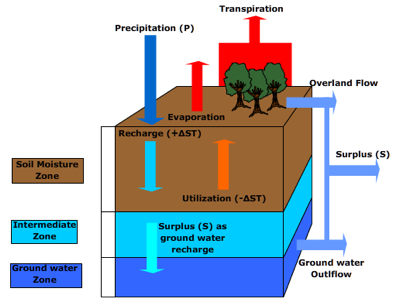The Water BalanceThe water balance is an accounting of the inputs and outputs of water. The water balance of a place, whether it be an agricultural field, watershed, or continent, can be determined by calculating the input, output, and storage changes of water at the Earth's surface. The major input of water is from precipitation and output is evapotranspiration. The geographer C. W. Thornthwaite (1899-1963) pioneered the water balance approach to water resource analysis. He and his team used the water-balance methodology to assess water needs for irrigation and other water-related issues. The Water BalanceTo understand water-balance concept, we need to start with its various components: Precipitation (P). Precipitation in the form of rain, snow, sleet, hail, etc. makes up the primarily supply of water to the surface. In some very dry locations, water can be supplied by dew and fog.
Actual evapotranspiration (AE).
Evaporation is the phase change
from a liquid to a gas releasing water from a wet surface into the air above.
Similarly, transpiration is
represents a phase change when water is released into the air by plants.
Evapotranspiration
is the combined transfer of water into the air by
evaporation and transpiration. Actual
evapotranspiration is the amount of water delivered to the air from these two processes.
Actual evapotranspiration is an output of water that is dependent on moisture
availability, temperature and humidity. Think of actual evapotranspiration as
"water use",
that is, water that is actually evaporating and transpiring given the environmental conditions
of a place. Figure 10.16 The soil water balance (After Strahler & Strahler, 2006) Potential evapotranspiration (PE). The environmental conditions at a place creates a demand for water. Especially in the case for plants, as as energy input increases, so does the demand for water to maintain life processes. If this demand is not met, serious consequences can occur. If the demand for water far exceeds that which is actual present, dry soil moisture conditions prevail. Natural ecosystems have adapted to the demands placed on water. Potential evapotranspiration is the amount of water that would be evaporated under an optimal set of conditions, among which is an unlimited supply of water. Think of potential evapotranspiration of "water need". In other words, it would be the water needed for evaporation and transpiration given the local environmental conditions. One of the most important factors that determines water demand is solar radiation. As energy input increases the demand for water, especially from plants increases. Regardless if there is, or isn't, any water in the soil, a plant still demands water. If it doesn't have access to water, the plant will likely wither and die. Soil Moisture Storage (ST). Soil moisture storage refers to the amount of water held in the soil at any particular time. The amount of water in the soil depends soil properties like soil texture and organic matter content. The maximum amount of water the soil can hold is called the field capacity. Fine grain soils have larger field capacities than coarse grain (sandy) soils. Thus, more water is available for actual evapotranspiration from fine soils than coarse soils. The upper limit of soil moisture storage is the field capacity, the lower limit is 0 when the soil has dried out. Change in Soil Moisture Storage (ΔST). The change in soil moisture storage is the amount of water that is being added to or removed from what is stored. The change in soil moisture storage falls between 0 and the field capacity. |
 Actual evapotranspiration increases as temperature increases, so long as there
is water to evaporate and for plants to transpire. The amount of evapotranspiration also
depends on how much water is available, which depends on the field capacity of soils.
In other words, if there is no water, no evaporation or
transpiration can occur.
Actual evapotranspiration increases as temperature increases, so long as there
is water to evaporate and for plants to transpire. The amount of evapotranspiration also
depends on how much water is available, which depends on the field capacity of soils.
In other words, if there is no water, no evaporation or
transpiration can occur.